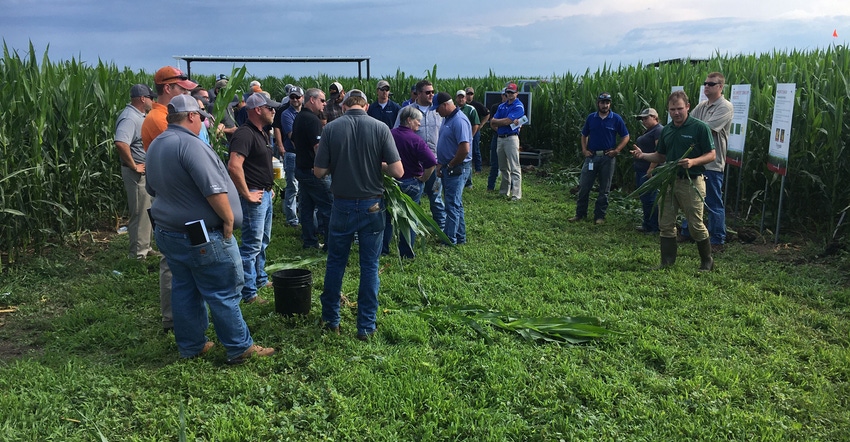
It goes without saying that today’s hybrids generally outyield those of 10 or 20 years ago. But just what has been gained after years of breeding in terms of how those hybrids perform under stress?
In 2017, agronomists at the Monsanto Water Utilization Learning Center near Gothenburg, Neb., set out to find these answers.
“We wanted to determine if newer corn products performed better and in what way did they perform better than older hybrids?” says Mark Reiman, agronomist at the center.
This involved five older Dekalb corn products, some from as far back as 2001, including DKC63-43, DKC60-15 and DKC61-69 brands, DKC63-07 and DKC56-54RIB brand blends. It also involved six newer products, DKC60-87, DKC60-67, DKC63-21, DKC64-34, DKC64-87 and DKC56-45RIB brand blends.
To test the differences between old and new, researchers imposed several different kinds of stress on the plants. For example, four blocks received full irrigation, while the other four received 25% irrigation. The 25% treatment received 2.7 inches of water for the year, while the full treatment received 9.2.

NEW VS. OLD: These ears were picked out of one row of an old hybrid, Dekalb DKC60-15 brand, and one row of a new hybrid, DKC60-87RIB brand blend. Both rows, each 17 feet in length, were subjected to the same stress conditions, and rows had the same amount of ears at 33.

“That’s one of the stresses we subjected the products to, and it was really the one that made a very dramatic yield difference,” Reiman says.
Difference under stress
“When we look at it under full irrigation, the new hybrids on average yielded about 17.1 more bushels per acre,” Reiman says. “There was some yield gain that way. The big difference was what happened when you subject these products to stress. That’s where we got 36 bushels. You were gaining more in those stress environments with the newer corn products.”
While this is only the first year of the study, Reiman notes the reason for the yield difference is likely because older products tended to not pollinate under stress.
“Under stress, sometimes the silks won’t push out very far or very fast, and the pollen might be shedding too much in advance of the silks coming out,” he says. “If those get too far apart, they won’t pollinate and newer hybrids or products seem to shorten that anthesis silking interval and handle that stress better.”
They also subjected the plants to density stress, with an above-average population of 36,000 plants per acre, and a below-average population of 28,000 plants per acre.

CORN UNDER STRESS: While newer corn products had an average 17-bushel-per-acre yield advantage over older products under optimal conditions, they stood out under stress with a 36-bushel advantage.
“What we found was you had more to gain out of the newer products. You have higher yields overall, but you had more to gain with 13.3 bushels in the newer products when you put them at 36,000,” Reiman says. “When you had those higher populations, you lost less when you subjected those to water stress. We lost about 10 bushels going to 36,000 in the stressed environments with the new hybrids. We lost about 26 bushels going to 36,000 in the old products.”
However, there are several components that contribute to density stress, Reiman adds.
“It’s not just seed per acre, but you’re competing with other plants in terms of the amount of water that’s available, because you’re trying to fit more plants’ root systems in that same area of ground. It’s one of those things that varies, but as products have advanced it seems like you’re seeing more ability to handle those higher densities.”
Gain over the years
Across all environments, this added up to an average 28-bushel advantage for newer corn products.
Some of the older products were from as far back as 2001 — some up to 2011. Meanwhile, the newer products were released an average of two years ago. With an average age difference of eight years between the hybrids, in full irrigation environment, there’s about a 2.2-bushel gain per year between the old hybrids and the new.
“If you look at that in a non-stress environment, you were getting about 2.2 bushels per year in gain. Every time you switched to a new product on average, you see that yield curve in the U.S. We incrementally keep going up, it’s about 2.2 bushels per acre,” Reiman says. “The surprising part is when you get to products under stress, that yield gain rises to about 4.5 bushels per acre. The products are gaining more in the stress environments than in overall good yield environments.”
Reiman notes overall, that adds up to more value in a bag of corn seed. Comparing two SmartStax products, the newer DKC56-45RIB brand blend with a yield in the stressed environment of 221.5 bushels per acre, and the older DKC56-54RIB brand blend of about 189.5, the difference is about 32 bushels for two 106-day products.
“When you look at it and we plant 2.5 acres a bag, with 32,000 [plants per acre], the average density in the trial, you’re getting 80 more bushels in that bag of seed. At $3 per bushel, that’s about $240 more a bag.”
About the Author(s)
You May Also Like




